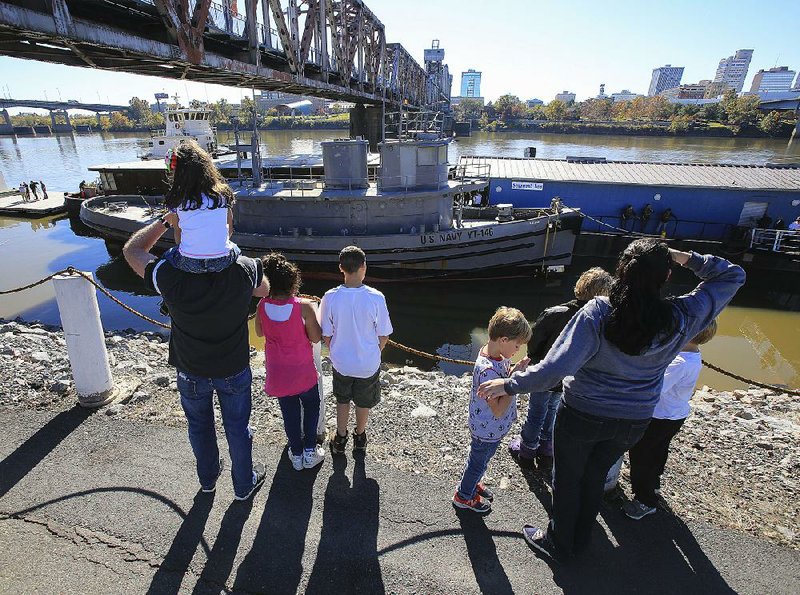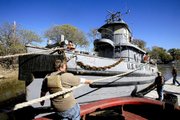More than 10 years after the Navy donated the Pearl Harbor-surviving Hoga to North Little Rock, the historic tugboat arrived Monday to take its place at the Arkansas Inland Maritime Museum on the city's downtown riverfront.
The Hoga, which earned National Historic Landmark status for its crew's work fighting fires and rescuing survivors from the Japanese attack on Pearl Harbor Dec. 7, 1941, gives the maritime museum the distinction of having vessels that served on both the first and last day of the United States' involvement in World War II.
The Razorback submarine, the museum's centerpiece since 2004, was at Tokyo Bay for the official Japanese surrender Sept. 2, 1945.
The Hoga will open to visitors during a 2 p.m. Pearl Harbor commemoration ceremony Dec. 7 at the museum, 120 Riverfront Drive, on the Arkansas River just east of the Main Street Bridge.
Some museum board members had said during the Hoga's transport -- which began in late September from the Pacific Coast -- that they feared the Hoga wouldn't make it in time for the ceremony. Instead, the boat came in exactly two weeks early.
Steve Owen, the museum board member who led the coordination with the shipping companies transporting the boat, said Friday that the Hoga's arrival by Dec. 7 was still up in the air. The ability to track the boat's tow location on the Mississippi River also had been inconsistent, he said.
But a towing exchange at Rosedale, Miss., between Pine Bluff Sand and Gravel and Jantran Inc., a subsidiary of North Little Rock-based Bruce Oakley Inc., fell into a timely connection, Owen said.
Both the Pine Bluff and North Little Rock companies donated their transport vessels to finish the Hoga's journey.
"Friday, at Rosedale, it was looking like there was going to be at least a two-day turnaround," Owen said after the Hoga was in place Monday. "What happened was she got in late Friday night [to Rosedale], and Jantran had a barge ready to go, so they came on.
"During the entire trip, whenever we would get a date for a transport, it would end up being two or three days beyond what we were told," Owen said of concerns about when the Hoga could arrive. "It's almost a surreal feeling right now that she's here."
Months of restoration work on the Hoga's interior is necessary before the entire boat will be available for tours, museum Executive Director Greg Zonner said. The boat's outside was previously repainted and its windows covered with steel plates, but that also needs further work.
Zonner said the museum has been working with the federal Environmental Protection Agency for a grant that would cover the costs to remove asbestos and other environmentally hazardous materials present inside the boat, launched Dec. 31, 1940.
"We've got to get it moved into place," Zonner said, referring to its reserved spot between the museum's two walkways. "We have to do some cleaning and painting on the outside. We'll do the topside first. The engine room won't be open until six to eight months. There's too much stuff down there to be removed."
There was only one problem bringing the Hoga into the museum Monday, when radio antennas and a mast almost struck the bottom of the Junction Bridge. But they were lowered enough to get through.
The Navy awarded ownership of the Hoga on July 28, 2005, to North Little Rock, which beat out four other groups wanting to preserve and display the boat.
The city and the museum have tried since then to arrange how to bring the Hoga to North Little Rock from the West Coast in a way that would meet naval requirements for protecting the nearly 75-year-old boat and also be affordable for the museum. The board has been raising private funds for years to cover the transport.
Getting the Hoga to North Little Rock was a project that former North Little Rock Mayor Patrick Hays began working on in 2000, followed by going after the Razorback submarine that had been part of the Turkish navy in its later service life.
The Hoga had more recently been a fireboat for Oakland, Calif., before being returned to the Navy in 1993 and placed on "donation hold" as part of the Navy's inactive fleet at Suisun Bay near San Francisco.
Hays, also a museum board member, was quite involved with the Hoga's transport, especially when an allegation of maritime violation earlier this month caused the cargo ship carrying the Hoga to divert to Houston after it wasn't allowed to off-load the Hoga at New Orleans.
Hays even flew to California for the first leg of the Hoga's trip in late September from the Mare Island Naval Shipyard at Vallejo, Calif., to San Diego.
The Hoga was then towed by another tugboat to Ensenada, Mexico, where it was lifted into a cradle on a cargo ship. The trip took the Hoga through the Panama Canal and had stops in Costa Rica and then Fort Lauderdale, Fla., before being rerouted from New Orleans to Houston.
"To be candid with you, I would have flipped a coin," Hays said Monday when asked if he believed the Hoga would still make it to North Little Rock after 10 years of waiting. "I was very concerned, but we never gave up.
"The biggest concern happened when she went from New Orleans to Houston," Hays said. "There was a good chance then that she might have gone back to Ensenada, Mexico, but here she is."
Metro on 11/24/2015


